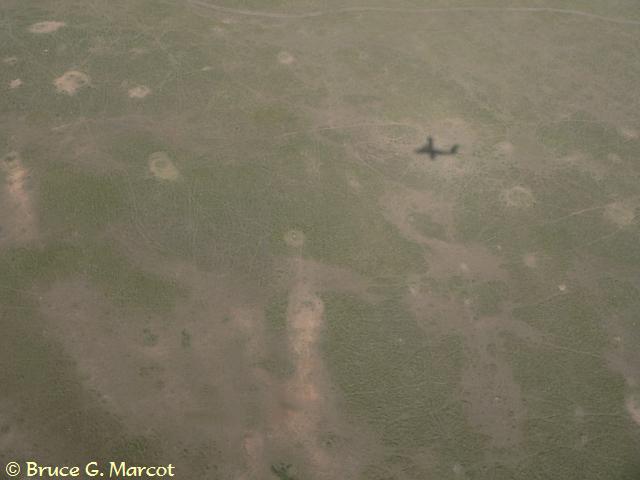
|
|
Animal Tracks in Masai Mara |
|
|
Click on images for larger versions
|
Masai Mara Grasslands, Kenya, Africa |
Credit & Copyright: Dr. Bruce G.
Marcot
|
Explanation: We are flying in a small propeller plane over the vast grasslands of Masai Mara National Reserve and Serengeti National Park along the border of Kenya and Tanzania. Below we see a treeless environment of dull greens and grays with occasional splotches of open dirt tracts. What is going on here? Mouse over the above photo and view the same image that I have enhanced to display many hidden features of this seemingly featureless landscape. What do you see? There are tracks and trails -- everywhere! Who made these, and why? Look closely at the tracks. A few are doubled, with parallel lines. These are obviously the work of field vehicles -- jeeps and land rovers that explore the area with tourists and the occasional wildlife researcher. But most of the tracks are single. These are mostly the trails made or maintained by ungulates of this environment ... African elephant, topi, Thomson's gazelles, warthog, giraffe, eland, Burchell's zebra, impala, Coke's hartebeest, Defassa waterbuck, black rhinoceros, African buffalo, and others. Elephants typically make the first tracks, which are then used and maintained by many other species. What are the bare round patches of ground? They are large termite mounds. Termite mounds are often used by gazelles, topi, and other antelope and ungulate species as a point to assert alpha dominance. They are also used by cheetahs as sight perches for hunting these ungulates. They are sometimes used by bat-eared foxes for denning within the mound, and for resting alongside the mound at dusk or dawn for warmth. Mongoose burrow into the termite mounds and their burrows are then occupied by lizards, snakes, and other species. Look for termite mounds in the enhanced image that have a complex of trails leading to them -- evidence of their popularity and high use and prominence in the network of travel lanes across the grasslands. Other patches of bare ground could be places where zebra, guineafowl, and other species have scraped the land raw as dusting sites, or by elephants. This view also might suggest that the scars of vehicle tracks in such a landscape may be but a small imprint compared to the use by so many animals. So add humans to the list of animals making and using these landscape lines. So what first
seemed to be a bland, featureless landscape is alive with signs of life and
movement. It is truly a physical manifestation of the web
of life!
|
Next week's picture: Bombus fervidus: Gold of the North
< Previous ... | Archive |
Index |
Location | Search | About EPOW | ... Next >
|
|
Author & Webmaster: Dr.
Bruce G. Marcot, Tom Bruce
Disclaimers and Legal
Statements
Original material on Ecology Picture of the Week ©
Bruce G. Marcot
Member Theme of Taos-Telecommunity